Herbs and spices have been used for thousands of years, not only to flavor food, but also for their incredible health benefits. They are truly a prime example of how great things come in small packages.
One of the most outstanding characteristics of most herbs/spices is the rich antioxidant content they possess. This, combined with other powerful compounds found in the plants, gives them anti-aging power and an ability to combat chronic inflammation and protect cells from damage.
Of course, each herb also has its own unique health benefits— as you will see— that range from supporting heart health to protecting brain function.
And while many herbs and spices are available in various supplements, what could be better than growing your own?
Awakening your inner gardener gives you access to fresh, potent herbs that you can be 100% certain have not been sprayed with chemicals— and are truly locally grown.
Plus, you don’t even have to have much of a green thumb to have success with the easy herbs to grow included in this article!
Growing Herbs is Easier than You Think
Whether you consider yourself a gardener or not, herbs make one of the best additions to your outdoor (and sometimes indoor) space.
Many of them thrive with little to no maintenance required, give you something green to look at, and have the outstanding benefit of being flavorful and edible.
Every herb you’ll read about here is one anyone can grow. You can easily source seeds if you want to be involved in the entire growing process, or you can buy starter plants from a local nursery to make things even easier on yourself (just buy organically grown plants whenever possible).
You can plant your herbs out in a prepared garden area, but they also do exceptionally well in pots placed on a patio/porch area. Some can even be grown indoors, although you will get better yields growing them outside.
The bottom line is that you do not need a lot of space or expertise to grow your own health-boosting herbs— just the willingness to put in a little time and effort for a great reward!
Fun Fact: The main difference between herbs and spices is that herbs are the leafy part of plants (think basil) and spices are the harder parts, including seeds, bark (think cinnamon), and roots. Many of the most commonly used spices are not easy to grow in your backyard, which is why nearly all the plants listed here are herbs.
Top 10 Easy Herbs to Grow
Mint (Mentha x piperita; Mentha spicata)
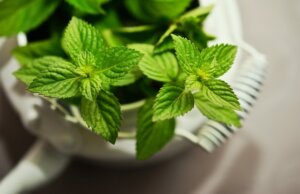
Mint, particularly peppermint (Mentha x piperita), has been valued since ancient times and used as a remedy for indigestion since at least as far back as the ancient Egyptian empire. Spearmint (Mentha spicata) is thought to be the oldest of all mints and is one of the parent plants of peppermint.
Key Health Benefits: Peppermint is an excellent digestive aid, and the oil from the leaves has even shown an ability to improve symptoms of irritable bowel syndrome (IBS). Menthol, a main constituent of mint leaves, has pain-relieving properties and may help calm the nervous system, potentially easing anxiety. Spearmint may improve cognitive function in older adults.
Hardiness: USDA Zones 3-11 (depends on species)
Type: Perennial
Sun Exposure: Full to partial sun
Typically Grows: 12-18″ tall, 18-24″ wide
Plant: In spring, after the threat of frost has passed
Notes: Mint grows so easily that it can become invasive. Plant in pots or a confined area to prevent the spread of runners. Can be grown indoors if you give it plenty of light.
Lemon Balm (Melissa officinalis)
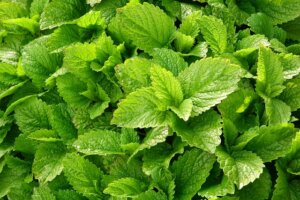
Lemon balm is a mint family member with citrusy undertones. Along with being one of the top easy herbs to grow, lemon balm has been used since the Middle Ages to improve sleep and mood as well as to treat wounds. It’s also an ingredient in Carmelite water, a German herbal spirit that dates back to the 14th century.
Key Health Benefits: Studies have shown that lemon balm can relieve stress and reduce anxiety. It also has a soothing effect on the digestive system, particularly by easing indigestion and reducing nausea. The essential oil from the leaves and hot water extracts (i.e., lemon balm tea) have shown antiviral properties as well.
Hardiness: USDA Zones 3-9
Type: Perennial
Sun Exposure: Full to partial sun
Typically Grows: 1-2′ tall, 1-3′ wide
Plant: After the last spring frost
Notes: Lemon balm is another plant that will happily take over the garden if given a chance. It spreads mainly by seed rather than runners, so clip off flowers that have faded to prevent seeds from dropping.
Parsley (Petroselinum crispum)
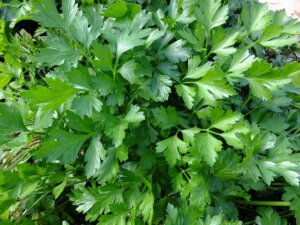
Parsley has unfortunately been regarded as little more than a garnish for many years. However, it has been valued for its health benefits since ancient times, including by the ancient Greek physician known as Galen. You can find it as either a flat-leaf or curly-leaf variety.
Key Health Benefits: Parsley is rich in vitamin A, vitamin C, vitamin K, folate, minerals, and antioxidants known as flavonoids that can protect cells from DNA damage. It also contains a compound known as apigenin that has demonstrated anticancer potential. Chewing on parsley naturally freshens your breath and may support heart health due to its high folate content.
Hardiness: USDA Zones 2-11
Type: Biennial typically grown as an annual
Sun Exposure: Full to partial sun
Typically Grows: 9-14″ tall and wide
Plant: Early to mid spring
Notes: Parsley grows best in cool weather and will fade in the heat of summer. You can replant it in fall for a second round.
Basil/Holy Basil (Ocimum basilicum; Ocimum sanctum or tenuiflorum)
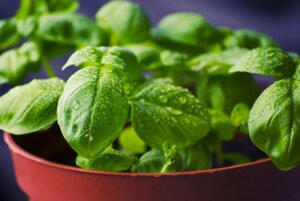
Both sweet basil and holy basil (also called tulsi) are incredibly easy herbs to grow. They have each featured in traditional medicine throughout the years— sweet basil in traditional Chinese medicine (TCM) for digestion and circulation and holy basil in Ayurveda for longevity and vitality.
Key Health Benefits: Sweet basil has antioxidant and anti-inflammatory properties that support digestion and may help protect against stomach ulcers. It may also protect cognitive function and combat depression symptoms. Holy basil is considered to be an adaptogen that can reduce stress and exhaustion. It’s traditionally used as a longevity tonic.
Hardiness: USDA Zones 2-11
Type: Annual
Sun Exposure: Full sun
Typically Grows: 18-24″ tall and wide
Plant: A few weeks after the last spring frost when the weather has warmed
Notes: Basil thrives in warm to hot weather and hates the cold. Be patient when planting and wait until nighttime temperatures are consistently above 50°F.
Oregano (Origanum vulgare)
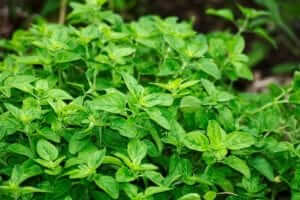
The name oregano comes from two Greek words (oros and ganos) that translate to “mountain joy” or “joy of the mountain”. This gives a hint to how popular oregano has been throughout the years, especially in the Mediterranean area where it grows natively. In folk medicine, oregano has been used for everything from indigestion to infections.
Key Health Benefits: Essential oils from the leaves of oregano have shown strong antibacterial properties in numerous studies. They contain a compound known as carvacrol that is particularly effective against food-borne pathogens and has strong antioxidant activity. Oregano has long been used for colds and respiratory illnesses and may even soothe a sore throat.
Hardiness: USDA Zones 4-10
Type: Perennial
Sun Exposure: Full to partial sun
Typically Grows: 1-2′ tall and wide
Plant: In spring, a few weeks after the threat of frost has passed
Notes: Oregano needs well-drained soil to thrive, so it will not do well in soggy areas. It does extremely well in poor (unfertile) soil where other plants won’t grow and is drought-tolerant— exactly why it’s on the list of easy herbs to grow.
Thyme (Thymus vulgaris)
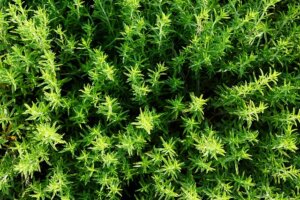
Thyme is yet another Mediterranean herb with powerful health benefits. It has been used for culinary and medicinal purposes since Roman times (and likely long before) and has been especially associated with courage and strength. Bundles of thyme were once burned to purify the air and ward off disease.
Key Health Benefits: Like oregano, thyme contains the compound carvacrol, which possesses antioxidant and antimicrobial properties. It has shown itself to be particularly effective against bacterial strains that cause cavities and other oral issues and even against antibiotic-resistant strains. Thyme may also have an anti-anxiety effect.
Hardiness: USDA Zones 5-9
Type: Perennial
Sun Exposure: Full sun
Typically Grows: 6-12″ tall and wide
Plant: After the danger of frost has passed and the ground has warmed
Notes: Thyme is drought-tolerant and can handle foot traffic, light mowing, and general neglect. In colder zones, it may need mulch over the winter to make it through.
Sage (Salvia officinalis)
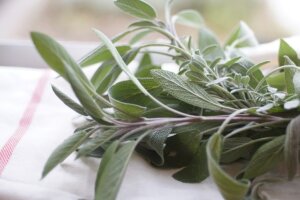
The botanical name for sage (salvia) comes from a Latin word that means “to save”. This could refer to its use during the Middle Ages to ward off the plague or simply to its frequent use in several different cultures for purification and protection.
Key Health Benefits: Researchers have found that sage has the potential to improve brain function in patients with mild to moderate Alzheimer’s disease. It can also help relieve hot flashes and other symptoms of menopause, is loaded with antioxidants, and may lower total and LDL (bad) cholesterol levels.
Hardiness: USDA Zones 4-10
Type: Perennial
Sun Exposure: Full sun (partial sun in hotter climates)
Typically Grows: 2-2.5′ tall and wide
Plant: In spring, after the threat of frost has passed
Notes: Sage is well up on the list of easy perennial herbs to grow. It tolerates neglect and is somewhat drought-tolerant but will struggle in poorly drained (i.e., soggy) soil. Prune out old woody sections in the spring to keep your plants productive.
Rosemary (Salvia rosmarinus, formerly Rosmarinus officinalis)
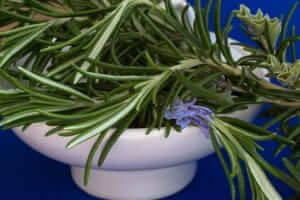
Rosemary has long been used as a medicinal herb (as far back as 500 BC!) and was famously quoted in Hamlet as an herb “for remembrance.” The name is derived from a Latin word meaning “dew of the sea,” which is a reference to its natural habitat growing along sea cliffs.
Key Health Benefits: Shakespeare may have got it right because rosemary has been shown to enhance memory and alertness and potentially help prevent cognitive decline. It may even reduce brain inflammation via its antioxidant power. Essential oils from the leaves of rosemary can also promote hair growth.
Hardiness: USDA Zones 8-10
Type: Perennial
Sun Exposure: Full sun
Typically Grows: 2-6′ tall, 2-4′ wide
Plant: In spring, once the danger of frost has passed and the weather has warmed
Notes: Rosemary is drought-tolerant and easy to care for, but it is sensitive to frost. If you live in USDA Zone 7 or colder, consider growing it in pots that can be overwintered indoors. Or grow it indoors all the time— just provide it with 6 or more hours of sunlight each day.
Cilantro/Coriander (Coriandrum sativum)
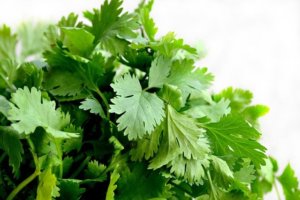
Cilantro has the unique benefit of being a plant that produces both an herb and a spice. The leaves of the plant (commonly referred to as cilantro in the U.S.) are the herbal part, while the seeds (called coriander) are the spice. Cilantro leaves do have a very polarizing flavor, but if you enjoy them, they are outstanding for your health.
Key Health Benefits: Cilantro leaves are full of antioxidants and contain good amounts of vitamins A and C. Coriander seeds are also antioxidant-rich and have anti-inflammatory properties. Coriander supports digestion, may help with IBS, and has activity against Salmonella. The entire plant may also help lower blood sugar levels.
Hardiness: USDA Zones 2-11
Type: Annual
Sun Exposure: Full to partial sun
Typically Grows: 1-2′ tall and wide
Plant: Early spring or in the fall
Notes: Cilantro grows best in cool weather and will quickly fade once temperatures rise close to 80°F. Otherwise, it’s relatively care-free, requires moderate watering and no fertilizer, and produces quickly. For coriander, allow the plants to flower so that seeds can form.
Chamomile (Matricaria chamomilla; Chamaemelum nobile)
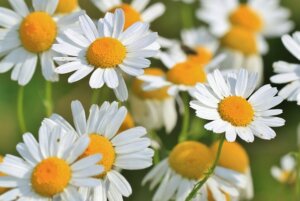
Chamomile rounds out the list of easy herbs to grow. It is truly one of oldest and most well-documented health-boosting herbs with references that date back to the time of Hippocrates (500 BC) and beyond. There are two main types of chamomile— German chamomile (Matricaria chamomilla) and Roman (Chamaemelum nobile). Both are beneficial, but the German type appears from research to be the more powerful of the two.
Key Health Benefits: Chamomile has long been used to promote sleep, a benefit that has received some confirmation from modern studies. It also has an anti-stress effect that has been found to reduce symptoms of generalized anxiety disorder (GAD). German chamomile contains the antioxidant apigenin, which has demonstrated immune-enhancing and anti-aging effects.
Hardiness: USDA Zones 2-9 (depending on type)
Type: Reseeding annual (German); Perennial (Roman)
Sun Exposure: Full sun
Typically Grows: 8-24″ tall, 8-12″ wide
Plant: In spring, after the last frost
Notes: Both types of chamomile are drought-tolerant once established and do equally well in the ground or containers. German chamomile will be killed by frost but frequently reseeds itself, while Roman chamomile is a perennial down to zone 4.
Easy to Grow Herbs for Your Garden and Kitchen
If you want to feel like you have a green thumb, look no further than the herbs listed here! They are all unfussy, tolerant of a little neglect, and ready to provide you with an abundant harvest.
Plus, each one has unique health benefits that add to their already outstanding flavor.
Get them going this spring or summer and enjoy freshly-grown herb power straight from your garden to your kitchen.


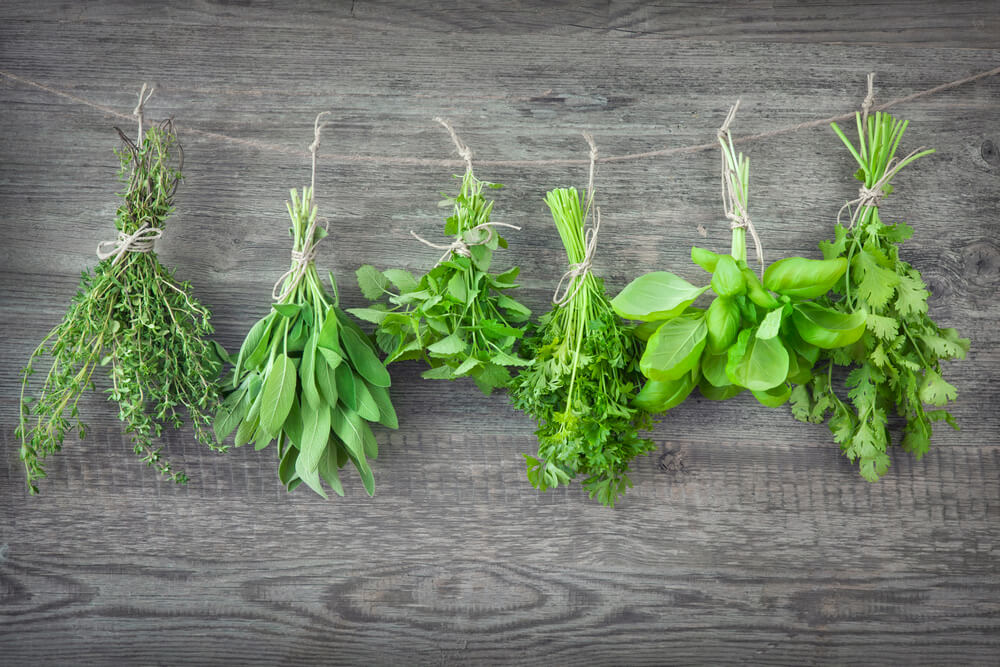
Great article .
Oooh – thank you so much.
I have 2 empty herb pots so off to garden centre to try & find organic grown herb plants. In uk so frost should hopefully past by. Great article i am suffering with arthritis in a knee due to injury years ago so keen on finding more natural remedies before trying pharmaceutical remedies. Great advice thanks will be sharing with my daughter to encourage her to start a herb garden for remedies for anxiety.
Great detailed information…..thanks so much. Love info like this. Keep ’em comming! 🙂